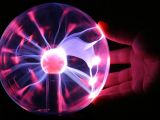They might have been extremely popular during the 1980's, but now you can hardly find one in any house. Personally I can't understand why, I mean they are fun to play with and produce some really cool light effects. The well known plasma lamps design was invented during the 1970's by a MIT student named Bill Parker; nevertheless, the original plasma lamps were first created by brilliant inventor Nikola Tesla while studying the effects of high frequency current discharged into low pressure gases contained by a glass tube.
Plasma lamps come in different constructive design and shapes, globes, domes, orbs and other, but they all work on the same basic principle. They can be usually found in the shape of a clear glass orb, containing a mixture of low pressure gases such as xenon, krypton and neon, although the gaseous mix is not preferential. The other glass shell houses a much smaller glass orb that has the role of the electrode. High frequency, high voltage alternating current is being pumped into the electrode with the help of a high voltage transformer.
A standard plasma lamp device uses an electric current having an oscillating frequency of 35 kilohertz and a voltage ranging from 2 to 5 kilovolts. As the lamp is being powered, the gas mixture inside it is ionized and gives rise to multiple beams of colored light discharges extending from the inner glass orb to the outer glass container. You might have observed how placing your hand on the outer glass shell determines the electric discharge to concentrate in a structure migrating from the inner glass orb to the point of contact between the hand and the glass orb. This is done by altering the high frequency characteristics of the current, meaning that the effect can be obtained with the help on any conductive object placed in the vicinity of the device.
Plasma lamps are mostly used as curiosities and to obtain unique light effects. In fact they have been used in many movies to render special lightning effects or strange objects such as alien spaceships, for example. They also have educational purpose, that is, they can be used to explain several physical aspects of electrical currents.
Because they use high-frequency electric currents to obtain the desired effects, plasma lamps present a series of potential hazards to the operators and other electrical devices widely used today. For example, the outer glass orb can heat up to dangerous temperatures, not enough to determine a failure of the device but sufficient to cause light burns. Plasma lamps are ideal sources of static charge, that could determine a high voltage discharge even through the plastic protective casing.
The high frequency of the current, respectively 35 kilohertz, produces parasite frequencies in the radio spectrum that could affect the operation of several house appliances such as the touch pad of a laptop or the correct functioning of several other digital devices. For example, cellular phones absorb radio frequencies that could prevent them from correctly interpreting the inputed commands, thus, while typing a number, the device would respond by executing a random command.
Also ozone gas, toxic to humans, may form on the outer surface of the glass orb after only a few minutes of operation, which could accumulate to dangerous levels if containers are placed over the plasma lamp.

 14 DAY TRIAL //
14 DAY TRIAL // 
